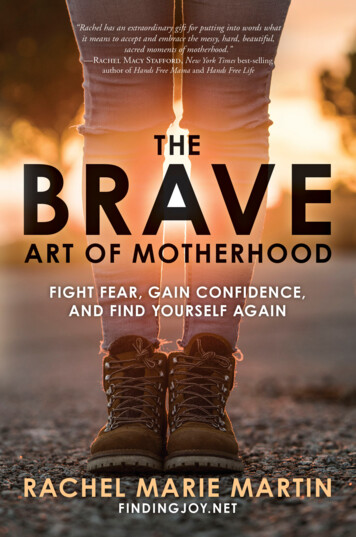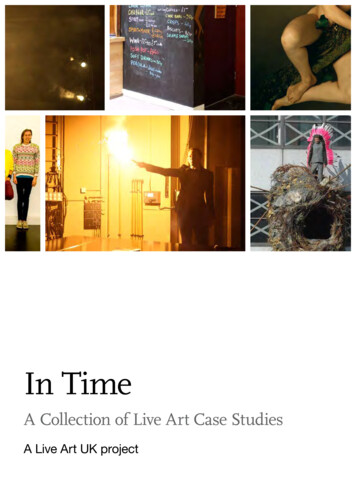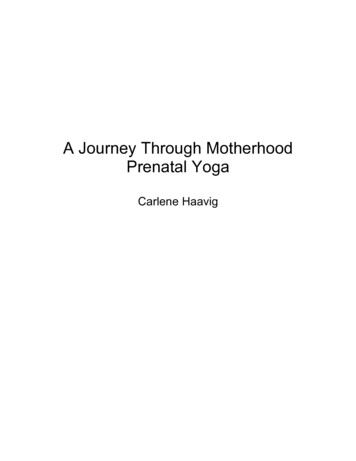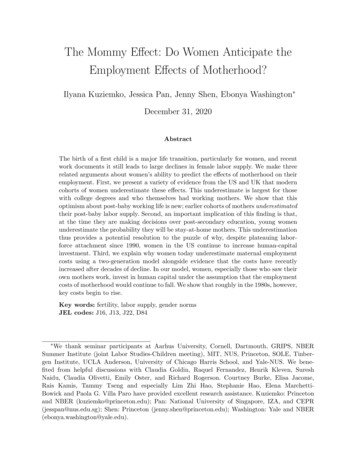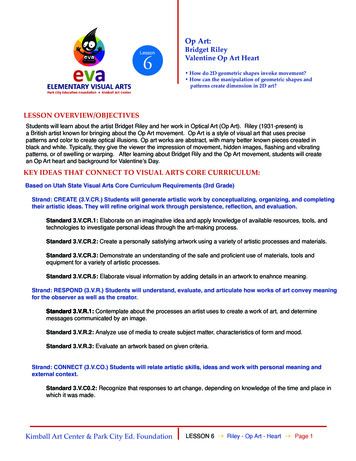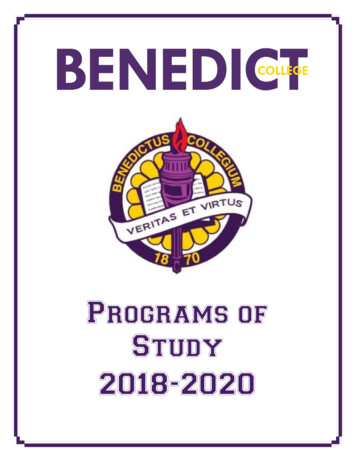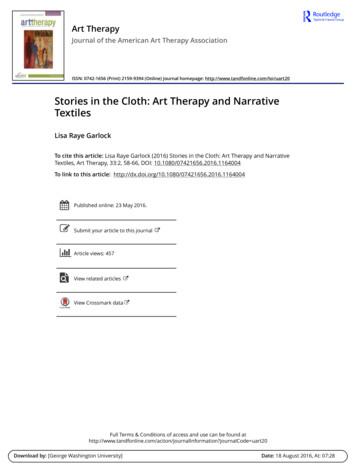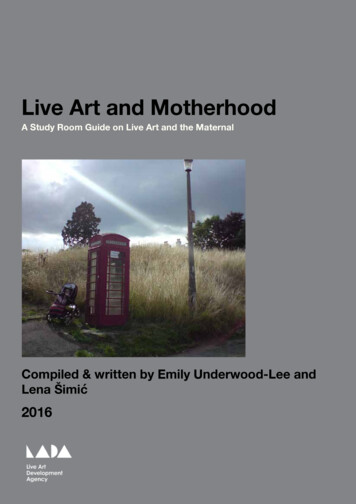
Transcription
Live Art and MotherhoodA Study Room Guide on Live Art and the MaternalCompiled & written by Emily Underwood-Lee andLena Šimić2016
LADA Study Room GuidesAs part of the continuous development of the Study Room we regularly commission artistsand thinkers to write personal Study Room Guides on specific themes.The idea is to help navigate Study Room users through the resource, enable them toexperience the materials in a new way and highlight materials that they may not haveotherwise come across.All Study Room Guides are available to view in our Study Room, or can be viewed and/ordownloaded directly from their Study Room catalogue entry.Please note that materials in the Study Room are continually being acquired and updated.For details of related titles acquired since the publication of this Guide search the onlineStudy Room catalogue with relevant keywords and use the advance search function tofurther search by category and date.Cover image credit: Fifteen Paces (traffic dependent), Maternity Leaves, 2013. Photo byLizzie Philps
1Table of contentsEmily Underwood-Lee and Lena ŠimićAn Incomplete and Completely Partial Rationalep.3Áine Phillipssex, birth & death / Eroticismp.7Anna FurseYerma’s Eggs / Subfertilityp.9Bean(m)other / the untitled / Queerp.11Clare QualmannPerambulator / Bordersp.13Elena MarchevskaValid until / Timep.15Emily Underwood-LeePatience / Griefp.17Grace SurmanI Love My Baby And My Baby Loves / Playp.19Helen SargeantM(other) Stories / Labourp.21Helena WalshIn Pursuit of Pleasure / Excessp.23Lena ŠimićMedea/Mothers’ Clothes / Belongingp.25Liz ClarkeI Tattooed My Baby / Conformityp.27Lizzie PhilpsMaternity Leaves / Resistancep.29MothersuckersBreastcups / Collaborationp.31
2Miffy RyanMy Nana’s Wedding (Gown) / Generationsp.33Tracy Evanscaesura / Erasurep.35Zoo IndigoUnder the Covers / Fantasyp.37Emily Underwood-Lee and Lena ŠimićAn Unfinished Responsep.39Study Room resources on artists featured in the Guidep.40Reading Listp.41
3An Incomplete and Completely Partial RationaleThis Study Room Guide on Live Art and Motherhood features fourteen individual artists andtwo artist collectives working in the mediums of Live Art and performance around the topicof the maternal. Motherhood and the maternal are difficult terms. There is an inherentessentialism and biology is often assumed. For us, motherhood refers to the livedexperience of mothering regardless of our route to it, whereas the maternal refers to thestudy of and representations of motherhood. All of the contributors in this volume aremothers but we hope this volume is of interest to both those who have cared for childrenand those who have not, after all, we all have direct experience of being m/othered. We areall first of all natals before we are mortals (thank you Hannah Arendt).This project is of its time, its generation, and its geographical location with its own set ofconnections and logic. It has been researched and written in 2015 and 2016. Many of theartists featured here came together through the research gathering Motherhood and LiveArt which was organised by Emily Underwood-Lee and Lena Šimić in January 2016 at theInstitute for the Art and Practice of Dissent at Home in Liverpool, part of the Study Room inExile series of events, in collaboration with the Live Art Development Agency.1 The artistswho were not present at that gathering yet are featured in this Study Room Guide havecome to our attention thanks to the women at the event and due to our own feministhistories. As authors of this Study Room Guide we raise our hands: we are guilty offavouritism and we are subjective. We admit that this is about personal connections,inspired conversations, common politics, solidarity, but also importantly, our own sense ofagency as artists and mothers.We (Emily and Lena) have worked together for a number of years sharing a commoninterest in autobiography and performance. Initially we met through the Women’s Writingfor Performance series of workshops at Lancaster University (2003 – 2006) and then, withfive other women performance practitioners, co-founded the Factory Floor network (2006 2016) for women solo performers and writers.2 Our energies and enthusiasm combinedagain under the common (practice as) research interest in ‘performance and the maternal’at the Motherhood and Creative Practice: Maternal Structures in Creative Workinternational conference at South Bank University in June 2015, organized by ElenaMarchevska and Valerie Walkerdine. This encounter activated our desire to research artistsworking on ‘maternal performance’. We were therefore delighted to be a part of A StudyRoom Gathering on Caring and Making, organised by Chloé Déchery and Mary Paterson,which took place at the Live Art Development Agency in July 2015. This gathering happenedin response to a large number of DIY 11: 2014 applications from artists who wanted todevise workshops around issues of care, dependents, parenthood/motherhood andchildren.We are not alone. The last few years have seen a proliferation of support networksdedicated to parents/artists. These include Artful Care, Mothers Who Make, Enemies of1Please see / for documentation of this event.Factory Floor was created in collaboration with Abi Lake, Caroline Wilson, Clare Duffy, Kerstin Bueschges andLouie Jenkins.2
4Good Art, Motherhood: A Social Practice, The Mums and Babies Ensemble, the Facebookgroup Artist/Mother Society, Parents in Performing Arts and internationally TheMothernists, Cultural ReProducers, Artist Parent Index, and M/Other Voices foundation, toname a few.It feels important to note all this past and present activity around the subject of arts andparenthood and position this Study Room Guide on Live Art and Motherhood as yet anotherincomplete attempt to map a somewhat disparate and disconnected but yet deeplyengaged artists’ community consisting of mothers working in the medium of Live Art. Whatis specific here? The artist/mothers featured in this guide have set out to make performanceand/or Live Art work about their particular maternal experience. All artist/motherstherefore engage with a specific set of methodologies of performance/Live Art making andinevitably develop a certain individual maternal performance aesthetic. This Study RoomGuide is about mapping the artists’ works and themes, creating an archive, and, on apragmatic as well as highly political level, giving visibility to this field and proclaimingmaternal agencies through and in arts making. Too often the mother has been invisible; asearch through the creative and academic archives reveals she is often second to her child,reduced to a screen on which to project the antipathy, reverence or hatred of the centralprotagonist: she is the source of his problems or oedipal anxieties. With this Study RoomGuide we wish to bring the mother centre stage, to celebrate the diversity of maternalperformance practice and artworks by mothers about mothering. This Study Room Guide ispart of our wider scholarly project; we wish to be part of the current movement to namematernal performance aesthetics and explore them deeper (please see our reading list atthe end of the guide).However, regardless of our common experience of identifying as mother/artists working inthe medium of Live Art, we are each different from one another. We are not a unifiedgroup, we do not represent an essential mother and we do not embark on our journeys tomotherhood through a common biological path. Instead we find unity and community in ourdifferent but related experiences as women who identify as mothers and artists. Our livedexperiences of class, race, sexuality, gender, age, religion, migration, dis/ability, financialstatus, (lack of) partnership, sense of recognition in our careers, in our communities, in ourcities and beyond, all matter and feed into our arts practice, into both outcomes andprocesses. Each artist has therefore been given a space for their own expression, taskedwith 300 words on a given topic, which is in dialogue with their arts practice. In inviting theartists to do their work in reflecting, naming and engaging with their practice, we have cometo imagine ourselves as ‘curators’ of this Study Room Guide. The readers are invited to enjoythe works and reflections, challenge their own preconceptions about motherhood andmothering practices, and add to the list of maternal performance practice, whilst lookingback to the past, sideways to the present and imagining our feminist maternal futures.This Study Room Guide is arranged alphabetically by artist’s first name (following feministtradition). Once we identified artists to ask to be part of this collection we explored theirwork; both as they had presented it to us and as we interpreted it. We identified a numberof themes and asked each artist or collective to write about their work in relation to aparticular strand we recognised in their maternal performance practice.
ongingNot all of the artists we contacted took up our invitation to write about their work and inour working process some themes disappeared; ethics, biology and reflection were droppedalong the way. However the themes that remain reflect the diversity of work being createdaround the maternal and inevitably illustrate the breadth of maternal experiences.In 2015 Bobby Baker recreated her seminal performance Drawing on a Mother’s Experience(1988) as Drawing on a (Grand) Mother’s Experience (2015) at the Southbank Centre inLondon. As feminist artist/mothers we are standing beside our feminist (grand) mothers.The works of Mary Kelly, Lea Lublin, Mierle Laderman Ukeles, Laura Mulvey, Susan Hiller,the Mother Art Collective, the Magdalena Project network and Bobby Baker have been asource of inspiration, challenge and constant re-negotiations in our own work. A StudyRoom Guide on Live Art and Feminism asks the question ‘Are We There Yet?’. Yet is still tocome. Looking to the future is a hopeful act, by thinking of our futures we can imagine otherways of existing in the world, other ways of living and making art within and around thematernal. Through the everyday struggles in motherhood, and its repetitious cycle fromgeneration to generation, we discover (anew) Live Art practice as a space of solidarity,creativity and openness.In January 2016, at the Study Room in Exile event Motherhood and Live Art we explored theways in which performance-based art on the maternal differs from visual and fine art. Whatis specific about motherhood being represented through Live Art/performance? Wecollectively wondered about liveness and risk, and placed it alongside our experiences as
6(failing, good/bad) artist/mothers. We created a temporary community, which arrived atsome quick conclusions in relation to Live Art and Motherhood. Later on, Emily and Lenamade notes: Temporality and durational performance entail multiple and complex connections tomaternal arts practice. Whilst there’s a mutual resistance against dominant narratives in lots of our work,we recognize each other’s specific struggles. Issues of representation are not easily solved and they seem impossible to escapein/through performance. Action doesn’t necessarily need to be juxtaposed with performance; they might beone and the same thing. There’s a desire towards articulating the unsayable: a kind of admiration formonstrous, corporeal, viscous and excessive mothers.Inspired by everyone’s contributions as well as further research into maternal performancepractices we started dreaming about the creation of a new kind of maternal performanceaesthetics which would entail and complexify all of those issues as well as take intoconsideration maternal care, interdependency, a new sense of time and attention,repetition, boredom and thirst for new collaborations between ourselves and our children.We still continue to long for a new kind of maternal performance aesthetics, which wouldseriously consider the ethical and political dimensions of working with/about children, butalso fight for visibility of our own ambivalent and precarious identity formations asartist/mothers. We are hopeful that the work of the artists represented in these pages willhelp us get there.Emily Underwood-Lee and Lena Šimić
7Áine Phillipssex, birth & death (2003)sex birth & death, 2003. Photo by Nigel Rolfe.Áine Phillips is a performance artist based in the west of Ireland where she is head ofsculpture at Burren College of Art. She has been exhibiting multi-media performance works,installation and video in Ireland and internationally since the late 80s. She has created workfor multiple contexts; public art commissions, the street, club events, galleries and museumsincluding City of Women Festival Ljubljana, Kyoto Art Centre Japan, Stanley Picker GalleryLondon, Bunkier Sztuki Krakow, and Mobius Boston USA. She has been involved in curatingmajor Live Art and performance events in Ireland such as Tulca Live 2005-2007 and FutureHistories 2016. Her edited book Performance Art in Ireland: A History was published by theLive Art Development Agency and Intellect Books UK in 2015. Her work is supported by theArts Council of Ireland.www.ainephillips.com
8EroticismI created sex, birth & death in 2002 and performed it five times from 2003-2004 in Ireland,the UK, USA and Austria. It is my favourite performance work and I consider it the mostdeveloped, original and culturally significant work I have produced. The subject matter isabortion and motherhood - juxtaposing the two linked experiences and showing them astwo sides of the one coin. The deeper underlying theme of the work is eroticism which Iused to open up new readings of maternalism.In our (Northern European) culture this physical pleasure in motherhood is denied. In mypersonal experience giving birth was like an enormous orgasm and breastfeeding arousedsexual feelings in my whole body. I am sure I am not alone in these experiences. A sexual actbegins motherhood, why would the entire experience not relate back to sexuality? Iarticulate this correspondence in my script “Two who are separate become one, two whoare one become separate.”In sex, birth & death I consider the image of lactation to be a metaphor for female eroticism.The experience of breastfeeding is of a flowing (expression) of nourishing and deliciousbodily fluid from one body into another. The breast milk is both food and a form of pleasurefor both and links mother and baby in a symbiotic relationship paralleling and extending theunity of two bodies in pregnancy.In sex, birth & death I made what I hoped was an erotic performance of the representationsof maternal experience. I hoped the audience would feel my expressed pleasure in mymothering body and witness the maternal body as erotic. I also intended to explicitly linkabortion with motherhood and eroticism. In Ireland, abortion is illegal and Irish womentravel to the UK to avail of abortion services. 100,000 Irish women have had UK abortions,but admitting or talking about it publicly is still problematic. I wanted to normalise theexperience of abortion and place it along the continuum of female sexuality.Áine Phillips
9Anna FurseYerma’s Eggs (2003)Helen Spackman in Yerma's Eggs, 2003. Riverside Studios. Photo by Hugo Glendinning.Anna Furse is Professor of Theatre and Performance at Goldsmiths where she directs theinternational laboratory MA in Performance Making and is Co-Director of the Centre of theBody. Her career in professional theatre includes over 30 years as a director, writer, projectleader, programmer, artistic director, curator, consultant and educator. Artistic Directorshipsinclude BloodGroup (1980 – 86) and Paines Plough (1990 -95). She founded Athletes of theHeart in 2003 with a Wellcome Trust Impact Award. Her many collaborative projects includeworking with hospitals and health organisations as well as international venues, including coproductions in France, Serbia and Slovenia. Her most recent work has been shown at venuesincluding the Cantieri Culturali Zisa, Palermo, Live Collision, Dublin and GIFT UK festivals, andthe Michael Cacoyiannia Foundation, Athens. Anna is the editor of Theatre in Pieces – Politics,Poetics and Interdisciplinary Collaboration (Methuen 2011) an anthology of performance textsthat includes Don Juan.Who?/ Don Juan.Kdo? her co-productions with Mladinsko Gledalisce,Ljubljana (Shunt and Riverside Studios 2008). Her current project The Anatomy Act iscommissioned by CREATE Dublin (premiering Live Collision 2016).www.athletesoftheheart.org
10SubfertilityLorca’s poetic drama Yerma (meaning 'barren'), about a desperate childless peasant, wasthe catalyst for this exploration into the subfertile psyche. I wanted to get under the skin ofthe subject via the body in performance and reflect complexity and contradiction via alayering of elements. With Assisted Reproductive Technologies (A.R.T.), the human heartcollaborates with highly invasive medical technology. We are impelled to reconsider ourethical assumptions. We subject our bodies to a necessary splitting - the separation of eggsfrom ovaries, sperm from testes, reproduction from sexual intercourse - as our sex cellsbecome involved in a spectacular process of fusion and, if successful, growth outside us.Given the statistic that 1 in 6 couples suffer involuntary childlessness and fertility problemsin the UK it is striking how little such stories are told. But then, the subfertile tend toimplode, muted, suffering with gritted teeth out of a sense of powerlessness, failure, guiltand marginalisation. Our voices rarely come through into the culture. It was such silence Ichose to break. My more recent theatre research has reflected a subjective perspective in atriptych of very different projects on (non) reproduction and correlative issues since 2000.Yerma’s Eggs was inevitably a highly charged, personal work bearing the stamp of each ofmy collaborators. The performer’s body remained central, clothed and naked, screamingand whispering. The piece began with water, the source of life, and ended with the voice ofmy child. In between these lay the material of a performance that was inevitablyuncomfortable for an audience. The subject is rife with contradictions, particularly forwomen. Splicing together a medical and technological world with the visceral elusivenessand tenderness of physical theatre posed many but necessary challenges. To do justice tothe subject matter, machine and flesh had to be married. Medical imperative on the oneside and embodied emotion on the other are the dualities that the sub-fertile straddles,daily. We medicate and meditate. We inject and project. We imagine.3Anna Furse3Extract from ‘Performing in glass: reproduction, technology, performance and the bio-spectacular’, inFeminist Futures: Theatre, Performance, Theory, edited by Geraldine Harris and Elaine Aston (PalgraveMacMillan USA, 2006).
11Bean(m)other/ the untitled (2014)(m)other / the untitled, 2014. Venice International Performance Art Week.Photo by Monica Sobczak.Bean's work is predominantly performance led, working through the intersections ofinstallation, video and sound. Her work has been described as deliberately “accidental,scattered, scuffed, blurry and incomplete”, a statement that she ferociously upholds in herattempts to undermine systems of patriarchy & capitalism through the aesthetic, materialand durational choices within her practice. As both artist and curator she is interested inproducing work that is quietly yet overtly political, lacks linear narrative and challenges itsaudiences. She is interested in curating spaces and situations that connect artists, makers,thinkers and feelers and has done so through the creation of ]performance s p a c e [ andongoing research into alternative modes of existence, queer theory, post-feminist realitiesand queer domesticity.www.beaninthearchive.com/
12QueerBy having a child my identity was automatically perceived as less queer. However everythingin this child’s short existence has been done somewhat queerly: from their conception inthe van I was living in in East London, to their home birth, their gender neutral name andown (neither parents) surname. Furthermore I feel the process of becoming mother hasdirect alignments with that of queer, firstly and simply that it’s a state of transition andbecoming (that breeds new states of transition and becoming also).I felt incredibly othered during my pregnancy and continuously judged on my physicalstatus. And it’s this physicality that felt to me the most queerly empowering: my body hasnever been so unruly, so leaky, so fluid and irrational, emotional and non-understandable(non-penetrable). I find it deeply saddening that patriarchy and capitalism have turnedpregnancy and parenting into something to be feared and bought into every step of theway. This should be the most potent force, the ultimate fuck you patriarchy I am life. Yetinstead pregnant women and mothers are belittled and herded into sanitised andconformist corners of identity & existence.He is not my husband, boyfriend, partner or lover. He is he and I am I and together we arenot one, not a family, not a unit. Sometimes when we sleep at night I think of us as a pack ofanimals, but that’s as together as we get. We learn from such a young age that it is not niceor good to put people into categories; people don’t live well in boxes. But in the home wecontinue to confine individuals to (gendered and aged) roles such as mother, father, child,sister, brother. If we could rid ourselves of these titles, their expectations and boundarieswe could all roam domestic geographies and subsequently our lives, more freely andhappily.4Bean4An excerpt from ‘To Destroy Capitalism We Must Destroy The Family’, available at Bean’s troy-capitalism-we-must-destroy-the-family
13Clare QualmannPerambulator (2014)Baby Slow Marathon, 2014. Huntly, Aberdeenshire. Photo by Clare Qualmann.Clare Qualmann is an artist/researcher with an interdisciplinary performance orientedpractice. Her work engages a range of participatory methods, and a breadth of media toexplore and reveal the overlooked - the politics and potentials of everyday life. She works atthe University of East London and The Cass where her teaching and research connectsstrongly to walking art practice, working on modules that forefront interdisciplinarity,participation and site specificity. A founder member of the Walking Artists Network, Clarecontinues to facilitate its occasional events and active online presence. Projects includewalkwalkwalk: stories from the Bethnal Green archive (2010) a permanent installation inBethnal Green Old Town Hall, Perambulator (2014) a participatory performance/walkingproject (with prams) for Deveron Arts in Huntly (Aberdeenshire), East End Jam (2015) acollaborative walking, foraging and jam-making project for the London Legacy DevelopmentCorporation, and WALKING WOMEN (2016) at Somerset House and Forest Fringe incollaboration with Amy Sharrocks.www.clarequalmann.co.uk/
14BordersOn Borders and PerambulatorIn 2012, when my son was a few months old, I was invited to make a walk for a project atLewisham Art House. Initially I ruled this out. My practice before would have requiredmultiple research trips, extensive walking in the area. This now felt entirelyunfeasible. Instead of saying no I decided to try to make a piece that would be possible todo with my baby in tow.Barriers. Boundaries. Edges. Limits.In the first months of his life, pushing his pram around the area that I had lived in for years, Iwas struck by the number of detours that I had to take: the route alterations, theimpediments to smooth passage. My very familiar routes through and to places were rudelydisrupted, forcing a new relationship with the physical details of the urban environment.Where you have to stop. Past which you cannot move or progress.A new radar evolves – seeking out the dropped kerbs and the ramps – avoiding steps,narrow gaps, awkward turns: going the long way round becomes the norm. Viewing the citythrough this new lens feels political. Losing the freedom of easy mobility – a freedom that Ihadn’t been aware of before – connects me to a massive group of people (predominantlywomen) in the same position, encumbered by wheels.Mold. Immobilize. Reduce.5This became the premise for Perambulator - making visible these issues through a masswalking with prams. Following the first Perambulator walk in Lewisham I went on to make amore extensive version of the project in Huntly, Aberdeenshire, exploring the pram walkingcultures of the town in a month-long residency as part of Deveron Arts ‘Walking Institute’(2014). Walking in a small town highlighted the borders and boundaries far more thanwalking in the city. The project became about finding them, testing them, crossing them,and taking others with me.Thus far and no further.Clare Qualmann5Marilyn Frye The Politics of Reality: Essays in Feminist Theory (Crossing Press, 1983) p. 2.
15Elena MarchevskaValid until (2009 – 2011)Day 106, Valid until , 2009-2011 video and performance. Photo by Elena Marchevska.Elena Marchevska is an interdisciplinary artist and researcher. Following her doctoral studyon screen and feminist performance practice, she continued to focus on the relationshipsbetween performance, maternal body and digital writing. She was a key organizer of theinternational conference ‘Motherhood and Creative Practice’ at London South BankUniversity in 2015, and writes about the intersections between maternal, creativity andactivism. She is currently working on research about radical self-organised performancepractices (focusing predominately on South East Europe) and their urban manifestation. Sheis a Senior Lecturer in Drama and Performance at London South Bank University andGraduate Advisor for Transart Institute, Berlin.www.elenamarcevska.com/
16TimeDiary entry, Day 91Living between two worlds can be demanding. Like an illness, you can’t escape from it. It isso deep in your body. It covers every border that protects you from outside. You canarticulate yourself on the screen, but deep inside you know that the screen neverarticulates, it only imposes form.Delivery at gate.There are two gates. One in. One out. And me in between.A: “We miss you so much”. Her eyes get tearful.I can’t deliver the news.B: “Maybe we will stay.”A: “Stay where?”B: “I am not quite sure .”How do you deliver a loss?My project Valid until (2009-2011) is an in-depth research on the theme of borders andmotherhood. It consisted of a series of autobiographical writing, performative photographsand videos taken during a period of 140 days. The period was symbolic, equal to onehundred and forty questions that I had to answer about myself, my children and my familyin the visa application. This is a challenge that repeatedly occurs in my life. Coming fromSouth East Europe (the ex-Yugoslavia region), my validity and legal status is constantly reevaluated and subject to the scrutiny of the Western European authorities. The period ofone hundred and forty days was a period of confirming the validity of my legal status in theUnited Kingdom. Borders can be built from outside, they can be physical and tangible,difficult to cross, but passable. I felt compelled as an artist to talk about the experience ofmotherhood as a highly political state, where the body is split and carries not only the childinto this world, but also cultural responsibility and an intergenerational take on the bordersthat youngsters have to cross. In my research and performative interventions, I looked atthe ways in which artist-mothers negotiate and translate their experiences with/on theborder.Elena Marchevska
17Emily Underwood-LeePatience (2009)Still from Patience, 2009. Photo by Emily Underwood-Lee.Emily Underwood-Lee is a failing feminist mother to two daughters. She is also aperformance practitioner and Research Fellow at the George Ewart Evans Centre forStorytelling at the University of South Wales. Emily creates autobiographical work and isprincipally concerned with the construction of gender and how the body can be presentedand represented in performance. Her research focuses on autobiographical stories and thebody in a variety of contexts including feminist performance art, narratives of illness,performance and the maternal, and performance and disability. Emily’s solo projectsinclude Titillation (2014), Titillation Grade 3 (2011), Patience (2009), and Ode to MortenHarket (2007).www.emilyunderwoodlee.wordpress.com
18GriefGrief is an instance where the mind is unable to contain and control itself or maintainrational reasoning. The fallacy that our bodies are under the control of our minds is broughtto the fore. The confusion of the emotional and physical sensations of grief, the flowing oftears, the involuntary rage and depression, all serve to illustrate the lack of control we haveover both our physical bodies and our emotional selves. Grief also breaks down our abilityto contain ourselves within the Symbolic.6 Grief not only destroys the Symbolic; it alsoliterally renders us outside language. It can leave us without words, or grief-stricken. We arestruck dumb by the power of our emotions; the mind and the body are united in theirinability to psychically or physically contain our grief. Patience is my attempt to find a way toperform the experience of grief which was such a profound part of my own journey tomotherhood.When I was 18 weeks pregnant I was diagnosed with a grade 3 invasive ductal carcinoma ofthe breast. I had a lumpectomy while I was pregnant. My baby was delivered 8 weeks earlyby caesarean section and spent a fortnig
This Study Room Guide on Live Art and Motherhood features fourteen individual artists and two artist collectives working in the mediums of Live Art and performance around the topic of the maternal. Motherhood and the maternal are difficult terms. There is an inherent essentialism and biology is often assumed. For us, motherhood refers to the lived
